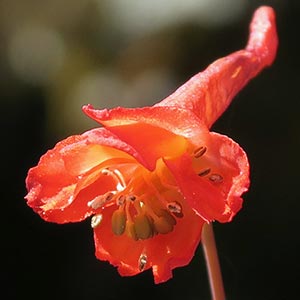Delphinium luteum
Delphinium nudicaule
golden larkspur, yellow larkspur
canyon delphinium, canyon larkspur, orange larkspur, red larkspur, red or orange larkspur, scarlet larkspur
20-40(-55) cm;
base often reddish, nearly glabrous.
(15-)20-50(-125) cm;
base reddish, glabrous.
blade round to pentagonal, 1-5 × 2-10 cm, nearly glabrous; ultimate lobes 3-5, width 8-30 mm (basal), 5-15 mm (cauline).
blade round to pentagonal, 2-6 × 3-10 cm; ultimate lobes 3-12, width 5-40 mm (basal), 2-20 mm (cauline).
5-25(-37)-flowered;
pedicel (1-)3-5(-7) cm, puberulent;
bracteoles 6-10(-17) mm from flowers, green, linear-lanceolate, 6-7 mm, nearly glabrous.
5-20(-69)-flowered;
pedicel (1.5-)2-6(-8) cm, glabrous to glandular-pubescent;
bracteoles 14-20(-30) mm from flowers, green to red, linear, 2-4(-9) mm, glabrous to puberulent.
sepals bright yellow, puberulent, appearing waxy, lateral sepals ± forward pointing, (11-)14-16 × (6-)9-13 mm, spur straight, ca. 30° below horizontal, 11-20 mm;
lower petal blades elevated, exposing stamens, 3-4 mm, clefts 0.5-1.5 mm;
hairs sparse or absent, ± evenly distributed if present, white to yellow.
sepals scarlet to reddish orange, rarely dull yellow, glabrous, lateral sepals forward-pointing to form pseudotube, (6-)8-13(-16) × 3-6 mm, spurs straight, slightly ascending, (12-)18-27(-34) mm;
lower petal blades elevated, exposing stamens, 2-3 mm, clefts 0.5-1 mm;
hairs sparse, evenly dispersed, yellow.
11-14 mm, 3.5-4.5 times longer than wide, glabrous.
13-26 mm, 3.5-4.5 times longer than wide, glabrous.
unwinged;
seed coat cell surfaces smooth.
unwinged or sometimes slightly wing-margined;
seed coat cells with surfaces smooth.
= 16.
Delphinium luteum
Delphinium nudicaule
Of conservation concern.
Delphinium luteum is presently known from only three populations. It is known to hybridize with D. decorum and with D. nudicaule. Populations of D. hesperium subsp. hesperium also occur at the type locality; D. luteum flowers earlier and hybrids are not known.
Delphinium luteum is not likely to be mistaken for any other species of Delphinium. It has been treated as a variety of D. nudicaule and is closely related to that species. Sepals of the infrequent yellow-flowered phase of D. nudicaule, however, have a much drabber appearance compared with the bright shining yellow of the sepals in D. luteum.
(Discussion copyrighted by Flora of North America; reprinted with permission.)
Delphinium nudicaule hybridizes with most other taxa of Delphinium that it encounters. Apparent hybrids involving D. nudicaule, and seen by the author (either afield or as specimens), include D. andersonii, D. antoninum, D. decorum, D. luteum, D. nuttallianum, D. patens, and D. trolliifolium. In addition, garden-grown plants have been hybridized with D. cardinale, D. elatum, D. menziesii, D. parishii, D. penardii, D. tatsienense Franchet, D. triste Fischer ex de Candolle, and D. uliginosum; D. nudicaule does not naturally occur with these species. Delphinium nudicaule is one of the earliest larkspurs to flower in any given locality. Douglas's type collection of D. nudicaule represents plants (synonyms D. sarcophyllum Hooker & Arnott and D. peltatum Hooker, an invalid name) grown under very moist conditions, probably quite near the ocean. The type specimen of D. armeniacum A. Heller represents plants grown under unusually dry conditions.
The Mendocino Indians consider Delphinium nudicaule a narcotic (D. E. Moerman 1986).
(Discussion copyrighted by Flora of North America; reprinted with permission.)


